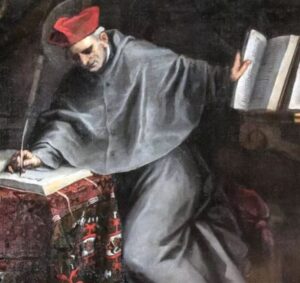30 July 2024
Saint Bonaventure, Part 2 | The Year of Prayer
By Joey Belleza, PhD (Cantab.)
Audio Player
In our previous reflection, we introduced the life and person of Saint Bonaventure, describing him as a mediator and unifier in a context of crisis for both the Franciscan order and for the Church at large. Now we can begin to consider one of his most famous works, the Itinerarium Mentis in Deum or Journey of the Mind to God, as a way to help us to think about prayer and union with God.
After Bonaventure was elected as Minister General, he went on retreat to Mount Alverna—the same mountain where Saint Francis witnessed a vision of a six-winged crucified seraph and thereafter received the stigmata, or the wounds of Christ on his own body. Moreover, Bonaventure identifies the crucifed seraph as Christ himself. Contemplating this episode of Francis’s life, Bonaventure recounts how the seraph’s six wings could be understood as “six levels of uplifting illuminations though which the soul is prepared, as it were by certain stages or steps, to pass over to peace through the ecstatic rapture of Christian wisdom. There is no other way but through the most burning love of the Crucified.” Just as the prophet Isaiah described the six seraphic wings as divided into pairs (“with two wings they covered their faces, with two they covered their feet, and with two they were flying”), the six stages of ascent in the Itinerarium are also divided into successive pairs. In this reflection, we will treat of the first pair of stages, wherein the mind considers God through the signs of the created world.
In stage one, the mind contemplates the wisdom, power, and goodness of God present in all creatures, and acknowledges God as the source of all created perfections. Through our senses, we observe the physical and sensible properties of various created things, such as the sweetness of honey or the refreshment of a spring, and we can attribute to God the maximum of these properties—God is most sweet or the source of all sweetness; God gives eternal refreshment to the soul. Thus, learning about the observable world through what we today call the natural sciences and the historical sciences can also help point us to God. Beyond the study of these sciences, which treats of creation and being in their changeable properties, we also can study being in itself, or the branch of philosophy known as metaphysics. Together, natural science, history, and metaphysics form part of this first stage of ascent, for they look as the world as it is, seeing glimpses of God’s wisdom across the breadth of creation.
In the second stage, the mind more deeply considers the created world but sees in the numerical and proportional harmony of creatures certain traces or vestiges of the mysteries of faith. Bonaventure explains this through, for example, the seven sensible properties of beings as reflecting the sevenfold perfection of the created order. Or, we can think about how an object giving delight is at once beautiful, pleasing, and wholesome (in Bonaventure’s alliterative Latin, speciosa, suavis, et salubris), and that this threefold delightfulness reflects the eternal Trinity. Therefore, in a first level of abstraction from the material and changeable world, the field of mathematics can also assist us in the contemplation of God, in that it helps us understand the universal harmony and structure of the created world. Here Bonaventure quotes Augustine: “number is the foremost exemplar in the mind of the Creator”.
These two stages, Bonaventure says, are “the two wings around the feet of the seraph”. In these lower levels of contemplation, we gaze upon the beauty of the created world, reflecting upon its proportionalities and harmonies, and see in them a faint trace of the Creator’s mind. Natural science, history, metaphysics, and mathematics are means for this end. Therefore, the role of physicists, engineers, mathematicians, and historians can also be prayerful enterprises, for they illuminate the divine wisdom present in the events of history and in the structure of creation. Let us therefore pray for scientists, mathematicians, and historians, that as they unfold the mysteries of the created world, we might more fully recognize and appreciate the mind of God present in all things.

